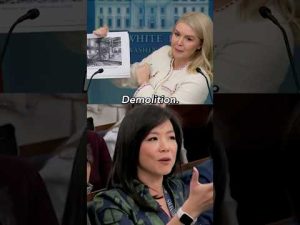In today’s political climate, change and development often spark controversy, especially when they involve something as symbolic and revered as the White House. Lately, President Trump’s decision to add a $200 million ballroom to the East Wing has set the stage for a heated debate. The criticism, however, seems misplaced and overlooks key facts that highlight the real benefits of this project coupled with the historical context of White House renovations.
First and foremost, it’s crucial to understand that this ballroom is not being funded by taxpayer money. This renovation is entirely supported through private donations, with the President himself contributing financially. The funds for this project come from individuals and sources willing to invest in the enhancement of the White House, rather than burdening the taxpayer. This stands in stark contrast to numerous other government-funded renovations across the country that come with a hefty price tag for taxpayers.
Critics have been quick to paint this endeavor as unnecessary, positing that no one “asked for” a ballroom at the White House. However, the reality is quite different. For over a century, there has been a desire among many for a proper ballroom in the White House. State dinners and gatherings with world leaders are significant events that require an appropriate venue. The ballroom will provide an elegant space to host these events, enhancing the nation’s ability to entertain and cultivate diplomatic relationships. Moreover, with completion set long before the end of the President’s term in 2029, President Trump will be able to enjoy its benefits personally, indicating that this project is indeed for future administrations and the nation’s benefit.
It’s also worth noting that presidential changes to the White House are not new. The history of the White House is filled with structural changes made by various administrations. Teddy Roosevelt built the West Wing in 1902. Franklin D. Roosevelt added an entire East Wing, although the indoor pool was actually built in 1933 in the West Wing courtyard. Each of these changes was met with some resistance at the time, yet today they are seen as integral parts of the White House’s evolution. Trump’s ballroom falls perfectly in line with this tradition of enhancing and modernizing the space to meet contemporary needs.
This project should also be evaluated alongside other public projects currently underway in different states. For example, recent government-funded renovations in Minnesota and California cost significantly more than the ballroom, and are funded by taxpayer dollars. Minnesota is expanding a state office building at a cost of $730 million, while California is undertaking a legislative office renovation for over $1.1 billion. These projects dwarf the ballroom’s costs and highlight a common issue faced by public-funded initiatives: ballooning budgets and an apparent lack of fiscal responsibility, unlike Trump’s ballroom, which is privately funded and thus demands efficient use of resources.
In conclusion, President Trump’s ballroom project for the White House represents a forward-thinking approach to enhancing America’s executive mansion without burdening taxpayers. It continues a historical tradition of Presidential improvements to the White House, while offering future administrations a state-of-the-art facility for hosting international summits and ceremonial events. Rather than being a point of contention, the ballroom should be seen for what it truly is: a valuable addition to the White House made possible through thoughtful private investment.







